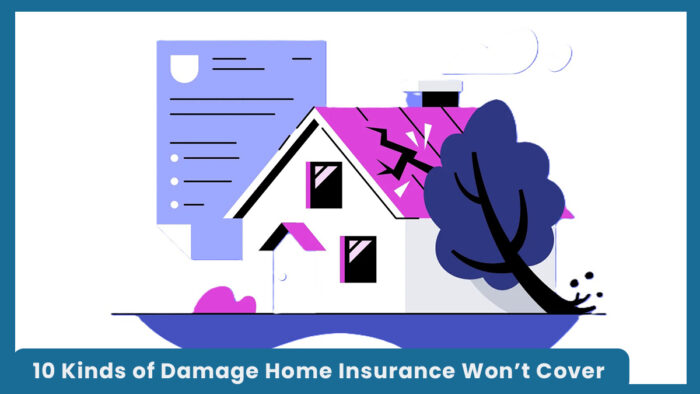10 Kinds of Damage Home Insurance Won’t Cover – Homeowners’ insurance offers important protection, but it does not cover everything. Understanding what is excluded can save you from unexpected costs down the road.

In this guide, we’ll walk through 10 kinds of damage home insurance won’t cover and explain how you can prepare for them. Even the most comprehensive policies have limits, so knowing these gaps is the first step to protecting your home and finances more effectively.
What Home Insurance Typically Does Not Cover
Home insurance offers protection for many risks, but it does not cover everything. Below are ten important exclusions every homeowner should understand:
1. Floods
Flooding caused by heavy rain, overflowing rivers, or storm surges is not included in most home insurance policies. To be protected, you need to purchase a separate flood insurance policy, often available through the National Flood Insurance Program.
Other forms of water damage, like sewer backups or sump pump overflows, are also excluded unless you add specific coverage for them. However, burst pipes are typically covered.
2. Wear and Tear
Insurance is not designed to pay for routine upkeep. Damage from everyday use, such as worn roofs, aging plumbing, or deteriorating floors, falls under regular maintenance and is not covered.
Proper home maintenance helps prevent costly repairs that insurance will not cover.
3. Infestations
Pests like termites, rodents, and bedbugs are not covered by standard home insurance. Infestation and the damage it causes are treated as maintenance issues.
If a pest causes a covered incident, like a fire, you might have coverage. But visible damage from pests is generally excluded.
4. Government Action
If the government seizes or condemns your property, your insurance policy will not pay for the loss. The only possible exception is if officials intervene to prevent a larger disaster, such as stopping a fire from spreading.
5. Ground Movement
Earthquakes, sinkholes, and landslides are not covered under most standard policies. In some states like Florida and Tennessee, insurers must offer optional sinkhole protection.
For broader protection, you can purchase separate coverage such as a difference in conditions policy.
6. Intentional Loss or Neglect
If your insurer finds that you caused the damage deliberately or failed to maintain your home properly, your claim may be denied. Intentional damage can also result in insurance fraud charges.
7. Aggressive or High-Risk Dogs
Due to the high cost of dog-related claims, some insurers refuse to cover certain breeds that are considered dangerous. These may include pit bulls, Rottweilers, and wolf hybrids.
Some insurance companies will assess your dog’s behavior instead of using breed restrictions, but having a high-risk dog could still impact your coverage
8. Mold
Mold coverage depends on its cause. If it stems from a sudden issue like a pipe leak, your policy might cover the damage. But if the mold is caused by long-term moisture or poor maintenance, it likely will not be covered.
Promptly addressing water issues can help you qualify for mold-related claims.
9. Wind Damage in Hurricane-Prone Areas
Wind damage is generally covered, but in coastal regions vulnerable to hurricanes, you may need to buy separate wind insurance.
Policies in these areas often include special deductibles based on a percentage of your home’s insured value. A five percent deductible on a $500,000 home would leave you responsible for $25,000 before your policy pays.
10. Nuclear Hazards
Damage caused by nuclear accidents is excluded from home insurance. Fortunately, nuclear power companies are required to carry their own liability insurance to protect nearby homeowners in such events.



